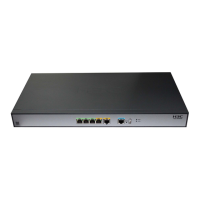30
Step Command Remarks
disabled.
Enabling 802.11g protection
reduces network performance.
Configuring 802.11g protection mode
802.11g protection modes include RTS/CTS and CTS-to-self.
• RTS/CTS—An AP sends an RTS packet before sending data to a client. After receiving the
RTS packet, all the devices within the coverage of the AP do not send data within the specified
time. Upon receiving the RTS packet, the client sends a CTS packet. This ensures that all the
devices within the coverage of the client do not send data within the specified time.
• CTS-to-Self—An AP uses its IP address to send a CTS packet before it sends data to a client.
This ensures that all the devices within the coverage of the AP do not send data within the
specified time.
To configure the 802.11g protection mode:
Step Command Remarks
1. Enter system view.
system-view
N/A
2. Enter WLAN RRM view.
wlan rrm
N/A
3. Configure the 802.11g
protection mode.
dot11g protection-mode
{
cts-to-self
|
rts-cts
}
Optional.
By default, the 802.11g protection
mode is CTS-to-Self.
Configuring 802.11n protection
The following matrix shows the feature and router compatibility:
Feature
MSR80
0
MSR
900
MSR90
0-E
MSR
930
MSR
20-1X
MSR 20 MSR 30 MSR 50
802.11n
Available
for
MSR800
-W and
MSR800
-10-W
No
Available
for
MSR900
-E-W
Available
for MSR
930-W,
MSR
930-W-G
U, and
MSR
930-W-G
T
Available
for
routers
with a
SIC_WL
AN
module
that
supports
802.11n
Available
for
routers
with a
SIC_WL
AN
module
that
supports
802.11n
Available
for
routers
with a
SIC_WL
AN
module
that
supports
802.11n
Available
for
routers
with a
SIC_WL
AN
module
that
supports
802.11n
Enabling 802.11n protection
When both 802.11n and non 802.11n clients access a WLAN network, interference easily occurs.
The access rate is degraded significantly because they adopt different modulation modes. To enable
both 802.11n and non-802.11n clients to operate correctly, enable 802.11n protection for an 802.11n
device to send RTS/CTS or CTS-to-self (the destination of the CTS packets is the device that sends
them) packets to non-802.11n devices, which then defer access to the medium.
The following cases require 802.11n protection to be enabled an 802.11n AP.

